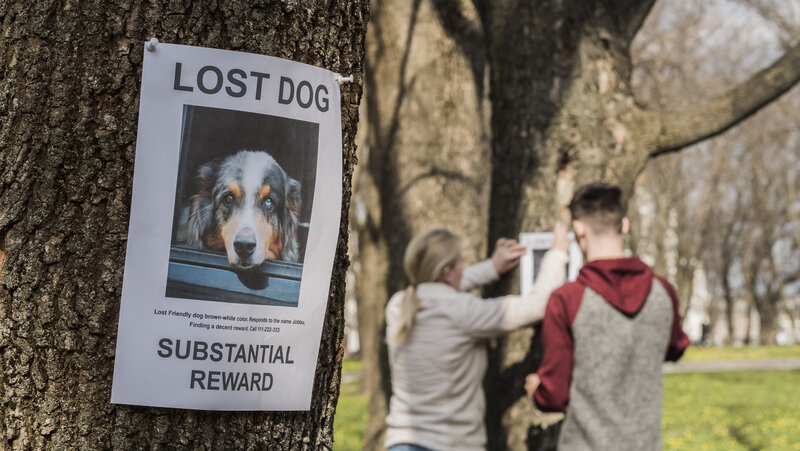
First, if you’re reading this post, you or someone you love lost their pet, and our hearts go out to you. We understand the helpless panic that sets in. The neighborhood never feels as large or complex as when you’re trying to find a lost pet.
Here are eight steps to follow as you work to find your pet. Time is definitely of the essence. Fortunately, your local veterinarians, shelters, and community pet lovers are on your side. All will help you find your pet once they have the correct information.
When you adopted your pet or had the vet microchip it, the chip number and your contact information were all registered with a microchip vendor. This information is all done online and digitally, but you also would have received paperwork confirming the chip’s number.
Contact the vendor ASAP and report your pet missing. Tractive.com offers this list of the most common microchipping vendor in case you need a mental job. And don’t forget, your vet (see next) may also have the information on record if you’ve forgotten it.
Once your pet is registered as missing, that shows up if the pet is found and scanned by animal control, shelters, or veterinarians in the area. You’ll be contacted immediately.
If someone sees a loose dog their first thought is to catch the dog if the dog is friendly. If the dog has a name tag you will be quickly reunited. Often times they may also call the local police department to report that they have found or spotted a loose dog. Animal control is dispatched to retrieve the dog and the dog will be placed in the city dog pound or shelter. When you call the police (animal control) make sure to leave your contact information along with a description of the dog. I also suggest visiting the pound or shelter just in case.
It only takes a few minutes to create a flyer you can post on social media, send to local veterinarians and shelters, and post it everywhere and anywhere around your community.
A Lost Pet flyer is essential because it provides visuals, and pertinent information about your dog/cat (including fears or triggers, favorite treats, etc.), and gets the information out to the people most likely to have seen or taken in your pet. You can create your own or take advantage of free online Lost Pet flyers, like this one from PawBoost.
You can create full 8.5 x 11 posters to hang on display. However, we also recommend creating smaller versions (like four per 8.5 x 11 sheet) that you can cut and hand out to people at local parks or local shopping centers so people get your pet’s image into the memory bank.
You can also visit PetFBI for more ideas on creating posters and where to put them. But, as they remind people, it is illegal to put them in mailboxes so resist the urge.
Let your veterinarian know via email. Send multiple pictures of your pet as well as a description of where/when they were last seen, that they are microchipped, a description of their collar and tags, etc. They are typically willing to post flyers (although larger vet offices may ask you to bring in your own).
The front desk staff can also provide a list of other area veterinarians and their contact information so you can email or reach out to them as well.
Shelters are dedicated to reuniting lost pets with their human companions. Most wait for at least seven to 14 days before putting a stray pet up for adoption. Call or email all the shelters in your local community and ask how they handle lost pet information.
Many of them ask for copies of your flyer or pictures/descriptions via email and then post them on their social media feeds. I also recommend visiting shelters in person just in case.
Social media channels are responsible for finding pets daily. The information spreads so quickly that it reaches a massive audience in a small amount of time. In addition to your own Facebook, Instagram, or NextDoor accounts, we also recommend sharing your lost pet posts on:
These will get you started. In addition, most communities have their own version of a Pet Lost & Found, which you can learn more about through your vet, shelters, or local pet supply stores.
Groomers are another great resource for finding lost pets. First and foremost, they’re pet lovers, their customers are pet lovers, and they serve the local community. Most are happy to post your flyers for you, too.
Also, if your pet is lost for several days, hides out in grasses with stickers, or is found matted or muddy, compassionate animal lovers may bring them to the groomer. So, even if the groomer hasn’t heard about or seen your pet yet, s/he may encounter them eventually.
According to petpedia.com’s stats from the ASPCA about 90% of lost pets are found within the first 12 hours - although many aren’t found for days or weeks. Dogs are typically found sooner than cats. Most indoor cats are found within ⅓ of a mile from where they escaped, while dogs are usually found within two miles of where they were lost.
This should give you hope, but it’s also a reminder that you’ll need to keep at it for a while. We recommend clearing the calendar for several days so you have time to search, take walks and call for them, pass out flyers, etc. The time you spend will be worth it when your pet is returned safe and sound.
Have you lost your beloved dog or cat? We are in communication with pet lovers in the area and have a broad social media outreach. We’re dedicated to finding lost pets and will get the work out to our network. Contact Alternative Canine Training and send pictures and relevant information. We wish you luck!